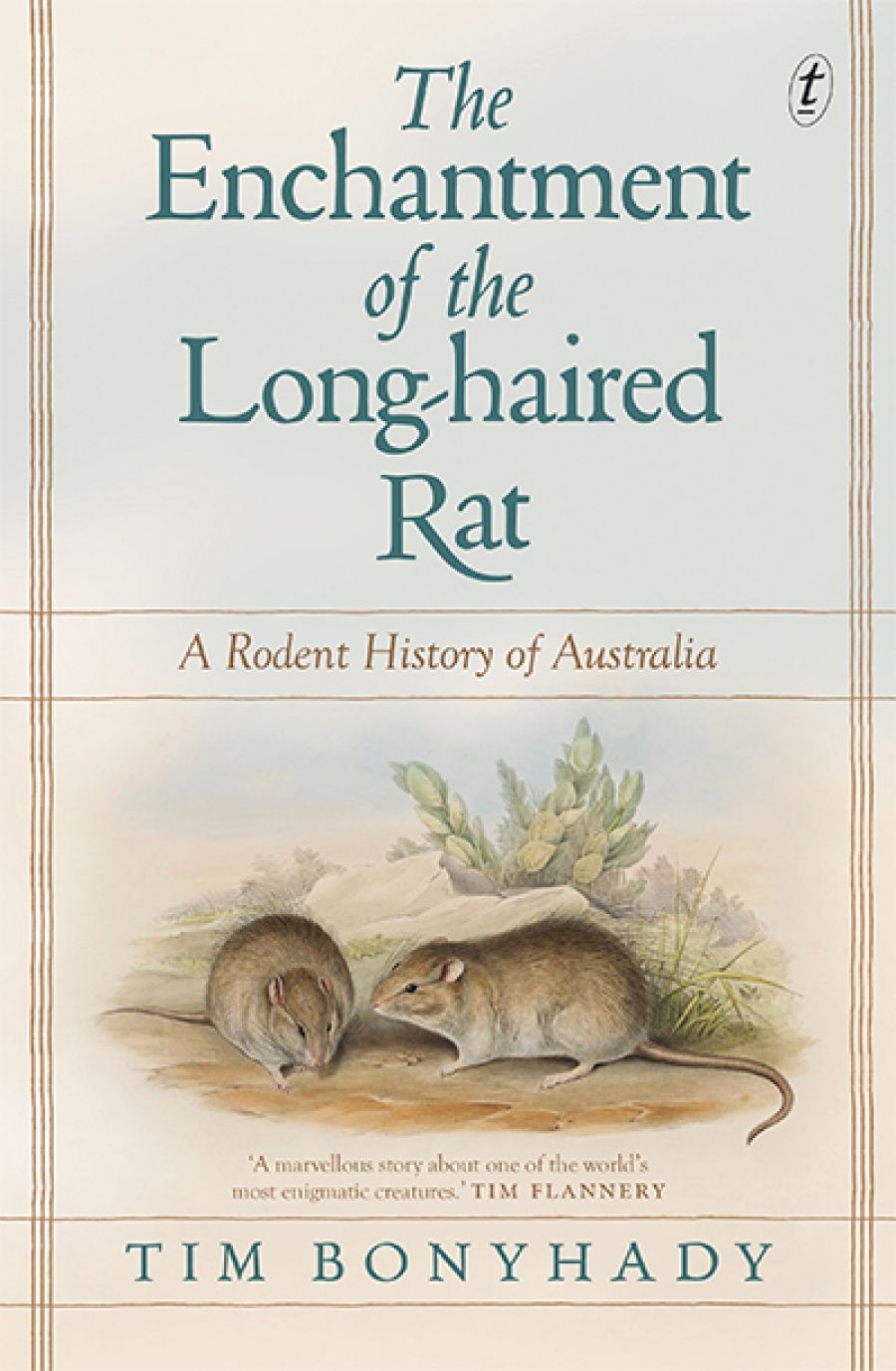
- Free Article: No
- Contents Category: Environmental Studies
- Review Article: Yes
- Book 1 Title: The Enchantment of the Long-haired Rat
- Book 1 Subtitle: A rodent history of Australia
- Book 1 Biblio: Text Publishing, $32.99 pb, 304 pp, 9781925773934
Writing a history enables detailed descriptions essential to understanding change over time. Bonyhady rightly notes that ‘the strictures of the academic journal article’ tend to exclude description in favour of novel findings and future action. Working beyond journals, Bonyhady unearths life histories of the animals in obscure places, capturing ‘baselines’ on which the animals’ future may depend. He begins with the plague year of 1861 in Burke and Wills country and follows naturalists, literary figures, and other sources (in roughly chronological order) to outbreaks further afield, wherever good descriptions are precise. CSIRO scientists Alan Newsome and Laurie Corbett were lyrical in their observations on their ‘fantastic’ night-time, torch-lit walks near Alice Springs in 1968–69. The rats ‘scurry’ along ‘worn trails’, ‘forage in open grassland’, and ‘squeak and fight in every corner’. Where the focus is merely the monetary value of the pests’ destruction, the records are less useful. The Longreach health inspector who costed the rats’ damage at ‘likely to average £1 per minute’ in 1931 failed to report evidence useful today. Now that the rats themselves are vulnerable, details of their everyday life before their habitats were severely compromised are increasingly important. When ‘now’ becomes the new normal (what ecologists call the ‘shifting baselines’ phenomenon), animals seemingly become extinct without warning.
Bonyhady crafts his history through a forensic analysis of detailed sources. The helpful map at the start of the book shows the key stations and rivers discussed. In 1874, William Ranken described the capricious climate of Australia as a ‘central oven’ that destroys ‘at uncertain intervals what it has reared in a few milder seasons’. The 1885–88 Long-haired Rat plague, which Bonyhady dubs ‘The Great Irruption’, was the biggest and most widespread event for which there are good contemporary records. It is a baseline for the bigger story of boom-and-bust ecological pulses in the interior.
The Great Irruption is observed by the brilliant bush naturalist Kenric Harold Bennett, whose detailed reports on the life patterns of the rat were a labour of love. Bennett, largely undiscovered until now, observes the animals as they cope with extreme climatic events. By 1888, ‘Year Four’ of the Great Irruption, the rats had reached northern Victoria, ‘further south than ever recorded before or since’.
 The long-haired rat – Rattus villosissimus. This species, also known as the native plague rat, can reach plague numbers in northern Australia and threaten cropping (photograph via CSIRO/Wikimedia Commons)
The long-haired rat – Rattus villosissimus. This species, also known as the native plague rat, can reach plague numbers in northern Australia and threaten cropping (photograph via CSIRO/Wikimedia Commons)
The rat is not the only animal to ‘irrupt’ in this land of ephemeral water and uncertain seasons. Indeed, learning to take refuge and hold out for better times is the secret of living with long dry spells, extreme temperatures, and sudden floods. One of the clever features of this history is pairing the rats’ stories with those of other fast-breeding opportunists: the rabbit, the night kite, the taipan, and, most destructive of all, the cat. The intertwined histories of the rat and the letter-wing kite, its original predator, appear in the early twentieth century in the pages of The Emu, the journal of the Royal Australasian Ornithologists’ Union, because the kites’ eggs were eagerly sought by oologists, and their nests were lined with rat fur. The rabbit, too, was important to rats. Bennett made his living as a rabbit inspector. While he grew tired of the ‘infernal rabbit business’, the job allowed him to record natural history in remote places. The cat story also takes an important twist in 1887, when the manager at Thargomindah brings in cats to attack the rabbits. Less than twenty years later, Sid Jackson, a leading bird collector, wrote of a ‘superabundance of ownerless cats’. By the 1930s, writer Ion L. Idriess was commenting that bird life was thinning out on the Diamantina because of animals ‘much larger than an ordinary domestic cat’. The feral cat is now scientifically documented as the arch-enemy of endangered small mammals, including native rodents.
Australia was once, in ecologist Tim Low’s words, ‘blessed with a bounty of remarkable rodents’. Bonyhady’s history explores this most threatened group of animals. The elegance of the writing and the inclusion of delicate quotations from past observers challenge lingering assumptions that all rats are bad, all plagues are bad, and anything that eats out the country is bad. Rather, Bonyhady seeks to restore dignity to the Mayaroo. How different would history have been if rats had been known by their Aboriginal name – like the koala and the kangaroo? In the boom-and-bust world of inland Australia, where ‘true indigenous rodents vastly predominate over the marsupial’, the irruptive Long-haired Rat is an important historical character, a key to life in the inland.
The last rodent in the book, the Melomys rubicola, did not fall victim to feral cats. Its home in the Torres Strait, Bramble Cay, collapsed under tidal swells. In 1998, the cay supported about a hundred animals. Just four years later, only ten melomys were left. By 2011, the small rodent with a mosaic tail was extinct. Bramble Cay is the site of the first mammal extinction on the planet caused by climate change. Bonyhady’s creative non-fiction complements the imaginative work of ‘cli-fi’ writers. Rather than apocalyptic futures, it explores the actual apocalypse of the past and present. His is a climate history that informs coming changes, where life in Australia’s ‘central oven’ is becoming increasingly difficult.


Comments powered by CComment